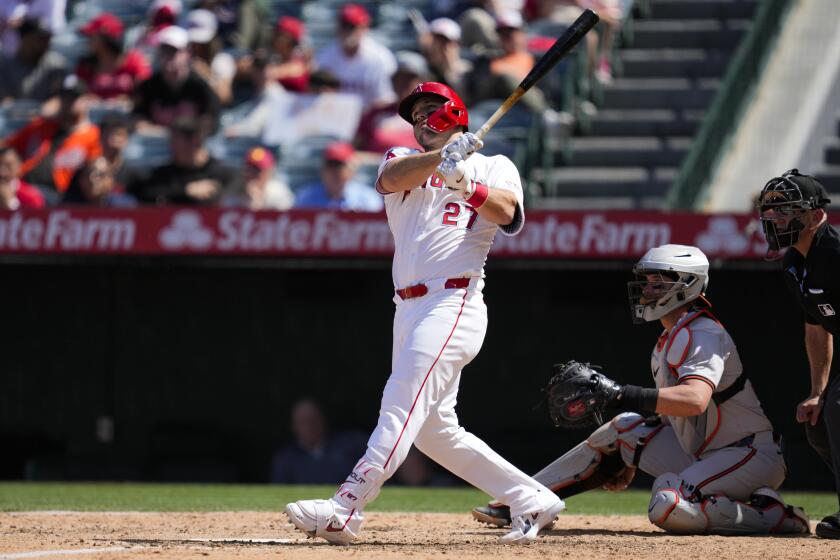Surgery saved his game, made his name
Tommy John is so intrinsically linked with the once-revolutionary, now-commonplace elbow surgery that bears his name that younger baseball fans might not realize he ranks among baseball’s all-time winningest pitchers.
Some might not even know that he played.
“The longer I’m out of the game and the more people have Tommy John surgery, the more people forget,” John says. “A lot of people think I was the doctor that did the surgery.”
Of course, he was not.
John, now 65, was a crafty left-hander, a sinkerball specialist with pinpoint control who pitched for 26 seasons in the major leagues and won 288 games, more than all but one other eligible pitcher not enshrined in the National Baseball Hall of Fame. Three times he was a 20-game winner, once with the Dodgers and twice with the New York Yankees, and four times his teams reached the World Series.
A four-time All-Star who also pitched for the Angels, John twice was runner-up in voting for the Cy Young Award, finishing second to Steve Carlton in the National League in 1977 and to Mike Flanagan in the American League in 1979.
But what keeps his name fresh in the minds of sports fans is not his pitching exploits, nor is it his current position as manager of the Bridgeport Bluefish of the independent Atlantic League of Professional Baseball.
It is this: He was the first to undergo an ulnar collateral ligament transplant, a career-saving procedure more commonly known as Tommy John surgery.
The brainchild of Dr. Frank Jobe, a famed Los Angeles surgeon and sports-medicine specialist, the transplant gave new life to John’s career and forever linked doctor and patient -- “joining us at the hip,” as Jobe puts it.
Jobe, 83, wasn’t sure the procedure would work but says he knew in 1974 that if John didn’t consent to it, his career would have ended right then.
“In those days, whenever a person had this kind of an injury, the word was, ‘He blew his arm out,’ whatever that means,” says Jobe, who will be honored by the Dodgers before Tuesday night’s game against the San Diego Padres. “They were sent back to the farm, or wherever it was they came from, because we didn’t know how to fix it and we weren’t quite sure what was blown out.”
In other words, it was a career-ending injury, a notion unacceptable to John, who was 13-3 with the Dodgers in 1974 before he was injured.
Jobe told the 31-year-old southpaw that he had an idea: He could transplant a tendon from John’s right wrist to his left elbow to fix a tear that otherwise would render him useless as a major league pitcher.
“He said, ‘What are my chances?’ ” Jobe recalls. “I said, ‘They’re not very good.’ I thought I could do it, but I wasn’t sure it would last.”
That was good enough for John.
“I’m no genius,” he says, “but if somebody tells you that you have zero chance of playing again if you don’t have it done, you say, ‘Well, let’s have it done.’ My chances may have been small, but at least they were there.”
Jobe performed the first elbow ligament transplant Sept. 25, 1974. One year and one day later, John was pitching in an instructional league. In 1976, he was 10-10 with the Dodgers and the comeback player of the year. He then won at least 20 games in three of the next four seasons, the last two in the American League after signing a free-agent contract with the Yankees before the 1979 season.
Says John, who will be at Dodger Stadium on Tuesday to honor the man who extended not only his career but thousands of others, “I trusted him as a doctor, but I knew him as a friend and I knew he would never tell me anything that wasn’t right. When he told me, ‘I really don’t know what I’m doing because I’ve never done this and I’ll need you to guide me,’ that’s when I knew I had the perfect doctor.
“He was saying that he was a normal human being and he was going to give it his best effort. I told him, ‘If you do what you have to do, I will more than do what I have to do. Whatever it takes, I’ll come back and I’ll pitch again.’ ”
John pitched 14 seasons after his surgery and won 164 games, only one fewer than Sandy Koufax won in his career. He never missed a start.
Says Jobe, “I was so excited, I could hardly stand it.”
Since retiring in 1989 after a second stint with the Yankees -- in 1987, he led them in innings pitched as a 44-year-old -- John has worked as a broadcaster, coach and manager. This is his second season with the Bluefish. He and wife Sally, married 38 years, live in Charlotte, N.C., and have four grown children.
He still hopes to be enshrined at the Hall of Fame.
But even if the veterans committee denies him, John notes, “I think I will have left a mark with Tommy John surgery, and then people will look up who Tommy John was and they’ll say, ‘Jeez, he was a pretty damn good pitcher, wasn’t he?’ ”
--
More to Read
Go beyond the scoreboard
Get the latest on L.A.'s teams in the daily Sports Report newsletter.
You may occasionally receive promotional content from the Los Angeles Times.




